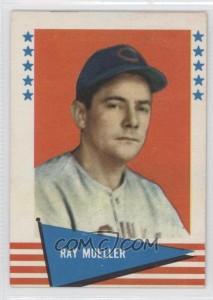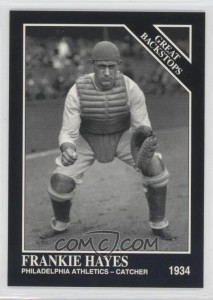Yesterday, I got to talking to former MLB pitcher Danny Graves on Twitter. He’s part of the team at the newly-launched 120Sports, a brand new sports network. It’s a cool concept, focusing on video analysis that is typically about 2 minutes long for each story, getting you up-to-the-minute updates on everything that’s going on.
Anyway, I asked Danny about his unusual career:
He did, in fact, average 3.41 pitches per plate appearance over his career, during which time MLB had an average of 3.73. That’s an 8% difference.
If we focus down on just one year, we can see a bit more detail. Take 2000, when Danny averaged 3.65 pitches per batter. He was the Reds’ closer that year, and one of 24 pitchers to save at least 20 games that season. The other 23 closers averaged 3.85 pitches per plate appearance, about 5% more than Graves. In fact, John Rocker, Armando Benitez, Troy Percival, and Dave Veres all averaged over 4 pitches per batter, while only 4 of the closers averaged fewer pitches than Danny (Antonio Alfonseca, Jeff Shaw, Jose Jimenez, and Steve Karsay).
So, it’s clear that Danny’s assertion that he tried to pitch to contact and limit pitches per batter is correct. This had another effect, though, which was first pointed out to me yesterday by Adam (@baseballtwit). Throwing fewer pitches per batter allowed Graves to face more batters and pitch more innings. Looking again at 2000, Graves threw the most pitches among those 24 closers. He tossed 1418 times against 388 batters. Compare that to Benitez, who tossed 1313 times against 304 batters. That’s only 105 fewer pitches, but against 84 fewer batters, which explains why Benitez averaged about 2/3 of a pitch more per batter.
In that 2000 season, the 388 batters that Graves faced produced 274 outs, meaning that he pitched 91.1 innings, and these were spread over 66 games. Benitez (who, remember, threw nearly as many pitches as Graves), produced only 234 outs. His 78 IP were spread over only 77 games. Benitez was the very model of the modern closer, tossing exactly one inning per appearance just about as surely as the sun came up every day. Graves, though, was used frequently in the 8th inning to record a 4, 5, or even 6-out save.
Did Graves’ desire to pitch to contact lead to more hits? Not in 2000, no. He allowed 7.98 H/9, whereas the other 23 closers allowed 8.06 H/9, and NL-wide average in 2000 was 9.20. So Graves was similar to other closers, who as a group were a lot better than league average. It did, however, affect his walks. In 2000, he issued 4.14 BB/9, as compared to 3.45 BB/9 from the other 23 closers. And if you throw out John Rocker, who issued 48 walks in 53 innings himself, the other 22 guys averaged 3.29 BB/9, putting Graves 25% above their average. This had a dramatic effect on his FIP, which was 4.59 as compared to his actual ERA of 2.56. That difference of 2.03 was by far the largest of the 24 closers, with the other 23 averaging a 0.44 difference (3.35 ERA, 3.79 FIP).
What, then, was Graves’ formula for success? For starters, in 2000, only 19% of the balls put in play vs. him, were line drives, as compared to the NL average of 25%. This is consistent with the notion that he tried to pitch to contact, presumably trying to be on the edge of the strike zone. This would tend to lead to poorer contact, but also more walks, both of which were true for Danny. He also induced double plays in 13% of opportunities, well above the NL average of 10%. The lack of good contact by batters also limited his extra base hits allowed to just 28% of total hits, as compared to 35% NL-wide and 30% among the other 23 closers.
It’s interesting that come 2001, Graves dropped his walk rate considerably, from 4.1 per 9 in 2000 to 2.0 in 2001 and 2.3 in 2002. The cost? More hits. His strike percentage jumped from 59.4% in 2000 to 68.1% in 2001 and 67.7% in 2002. As he was around the strike zone more, batters made better contact, with their line drive percentage climbing to 24% each season, and his H/9 rose from 8.0 in 2000 to 9.3 in 2001 and 9.0 in 2000. Thanks to the reduction in walks, his FIP over 2001-2 was 3.66, much closer to his actual ERA of 3.62, as opposed to the huge gap in 2000.
In his final years of 2004-2006, Graves was used like a modern reliever, averaging exactly 1 inning per appearance (121 games, 121 IP). He kept his walk rate down at 2.8 per 9, but his K rate stayed low, at 4.7 per 9. His extra-base hit percentage soared to 38% as a lot of balls left the yard (11.6% of his fly balls allowed were homers, well above league average). I’m not sure why Danny’s approach changed. In might have been out of necessity, but clearly as he threw more strikes, he was hit harder. Issuing fewer walks did not benefit him, and in fact led to more hits and a higher overall WHIP.
As Adam pointed out to me, Graves was pretty much the last MLB closer who consistently averaged over 1 inning pitched per appearance. In his prime, he wasn’t afraid of walking people and made up for it by getting double plays and not allowing extra-base hits very often. By the end of his career, when he pitched more like a modern closer (strictly 1 inning pitched, low walk rate) he was actually less successful. Maybe this is a sign that today’s relief pitching isn’t as optimized as many folks think.


